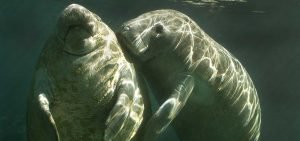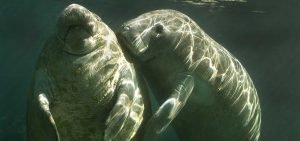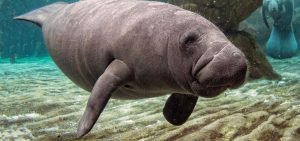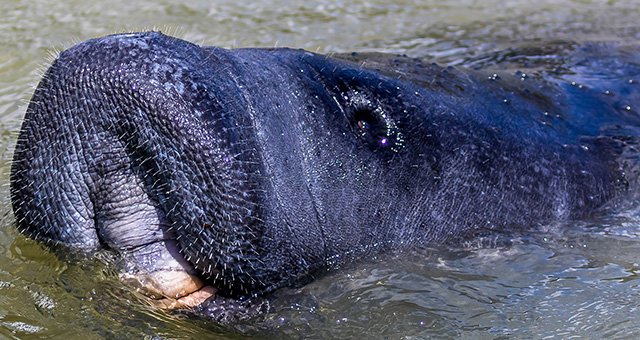Spotting Manatees During Manatee Season
May 23, 2022

The Florida manatees you will see in Southwest Florida are a subspecies of West Indian manatees, which live in the waters around Florida, the Caribbean, Central America and northern South America. You may even see a female manatee, called a cow, with her baby, or calf. Male manatees are called bulls, but they do not have any kind of paternal presence after mating.
Since manatees have few natural predators and are not territorial, they are fairly solitary and do not need to travel in herds. They will, however, come together in informal groups when they need to share food sources or warm water – the latter of which brings them to the Southwest Florida area.
Although the thick, leathery skin of manatees may suggest otherwise, these docile creatures do not do well when water temperatures dip below 68 ̊F. They are prone to a cold-related disease called cold stress syndrome, which can prove to be fatal.
When the water starts to cool, hundreds of manatees seek shelter along the shores of South Florida.
Southwest Florida is an excellent place to enjoy the animals in a non-captive environment. We host boat tours, which will take you up close and personal to where the manatees will typically be found and you can greet an entire group of manatees from atop the boat while exploring the area and other beautiful natural wildlife that the area has to offer.
The serene waters create a haven for manatees, giving you a unique opportunity to encounter the creatures.
Florida manatees are enormous mammals and should be treated as such. They are peaceful creatures, but please keep your distance if you opt for paddle boarding and you paddle about, and do not travel over resting manatees because they could resurface at any time.
If you accidentally find yourself too close to a sea cow, just slowly paddle back until you are a safe distance away. All in all, if you give them space, avoid touching them and speak quietly in wildlife areas, you are bound to have an incredible manatee-viewing experience. It is never too early to plan your winter vacation – packed with sea cow sightings and an endless list of year-round adventures.
Florida Manatee season started on November 15 and runs through to March 31. As air and water temperatures have been dropping through cold fronts this year, manatees have moved south for warmer water refuge, and slower seasonal speed limits have gone into effect. Boaters are cautioned to be on the lookout for greater numbers of manatees moving into the waterways. When the weather is cold, the majority of manatees can be found in the warm-water refuges. When temperatures are warm, manatees move into surrounding canals and the Intracoastal Waterway to forage, increasing the chance of manatee/boater interaction.
Boaters should be aware that many seasonal manatee protection zones go into effect throughout the state on November 15 and run thru March 31. For information about manatee protection zones by county, including seasonal changes, visit the Florida Fish and Wildlife Conservation Commission (FWC) website and click on “Data and Maps.” At the bottom of the page there is information on FWC Manatee COLD-weather changes to speed zones.
When in the Naples, Florida area, taking a manatee sightseeing eco tour is a great way to enjoy a close view of Florida wildlife. Manatee Eco-Tours out of Naples is the only sightseeing tour company in the world that sees manatees everyday all year. We offer an informative 90-minute tour that will allow you to see manatees in their natural habitat. It is very likely to also see other types of wildlife, such as alligators, egrets, dolphins, sea turtles and other animals that are indigenous to the area during the tours. The tours take you and your group to the Faka Union Canal, which is part of the Port of the islands and the 10,000 islands.
Naples Manatee Eco-Tours
March 16, 2022

Naples Florida is a paradise for natural wildlife and home to some of the most unique ecosystems in the United States. Located on the Southwest portion of Florida, Naples has a great number of natural visitors, from alligators and big game fish to all kinds of aquatic wildlife. The real attraction is our resident manatees, as Southwest Florida is home to the one of the largest concentration of manatee in North America. We are also one of the only places in Florida where manatees are found year round!
Our eco-tours are designed to be a view of some of the world’s most beautiful natural habitats, with direct access to the beautiful creatures of the region. We take great care to preserve the natural beauty of the Naples, Florida coast that surrounds us, and our manatee population is no exception.
Come by and let us take you on a boat tour to see our family of Florida manatees. We have boats and tours leaving every day and our guides will take you to the manatees in the area, where you can see them playing and swimming in their natural habitat.
Ecotourism offers an opportunity for an increase in education and activism among travelers, making them more effective supporters of conservation.
We offer an informative 90-minute tour that will allow you to see manatees in their natural habitat. It is very likely to also see other types of wildlife, such as alligators, egrets, dolphins, sea turtles and other animals that are indigenous to the area during the tours. The tours take you and your group to the Faka Union Canal, which is part of the Port of the islands and the 10,000 islands.
For more information about the Eco-Tours and manatee sightseeing tours available, please call us today.
See Manatees in Naples Florida
January 26, 2022

Manatees roam the waters of southeast Florida from April through October—but when things get a bit chilly, they head to places like freshwater Florida springs, where the temperatures remain constant throughout the year.
It may not seem warm when you jump into a freshwater spring, but the water temperatures remain around 70 degrees, which is perfect for manatees in Florida who need that kind of warmth to survive.
Seeing a large number of Florida manatees in one place is an amazing experience, but just remember these gentle sea cows are there for survival. Whether you’re on a solo kayaking trip or a manatee swim tour, always mind your “Manatee Manners”— look, but don’t touch.
The U.S. Fish and Wildlife Service has produced several videos on interacting with manatees, whether it’s by swimming/snorkeling, boating or kayaking. There’s even information that’s specifically for photographers and videographers.
Remember to respect these precious creatures and the environment in which they live. Naples provides one of the best places to see manatees in their environment. We offer manatee eco-tours and an experienced staff who will take you to see the manatees, while offering important information regarding manatees and their habitat.
So Where do you Find a Florida Manatee?
December 29, 2021

The manatee, Florida’s gentle giant, also known as the “sea cow” can be spotted in the largest numbers during the winter and early spring. When water temperatures dip below 68 degrees manatees gravitate towards warmer waters making Florida’s 72-degree freshwater springs an ideal respite for the warm-blooded mammals. The added benefit is that we can observe them in the clear water.
Manatees are often found congregating around bubbly springs, within state and marine water parks, or near power plants where the outflow of warm water keeps their body temperatures constant. Now is a good time to look for these true Florida natives, because as summer approaches, these endearing creatures will scatter.
Manatees are related to the elephant, with grayish thick, leathery wrinkled skin. Propelled by huge powerful tails but slow swimmers, they lumber along quietly through Florida’s waterways. If you look you can find them year around in Florida but it is much easier in cooler months when large numbers cluster near the temperate water.
As herbivores, manatees usually dine on marine and freshwater plants, grazing along grass flats and aquatic meadows, surfacing for air while breathing through their whiskered nostrils. These gentle creatures are definitely heavyweights, tipping the scales anywhere between than 1,000-3,500 pounds and consuming up to ten percent of their body weight in marine vegetation each day. The females give birth to calves typically weighing more than 60 pounds as they nurse under water.
So where do you find a Florida manatee?
There are various places to see our state’s unique underwater mammals. Some locations have platforms where visitors may observe from lookout decks. Many parks have created boardwalks adjacent to waterways where manatees can be seen in mass.
We offer outdoor adventure trips with a special focus on manatee trips by boat where adventurers can get a very close look at manatees. There are strict rules about keeping a safe distance from the official marine mammal of the State of Florida and our experts are familiar with these rules, while ensuring you the best possible view of them. Our expert guides are trained to spot the enormous creatures while providing information about how to both observe and protect these endangered species.
Manatee Eco-Tours out of Naples is the only sightseeing tour company in the world that offers and stands by it’s NO SEE-NO PAY guarantee. We offer an informative 90-minute tour that will allow you to see manatees in their natural habitat. It is very likely to also see other types of wildlife, such as alligators, egrets, dolphins, sea turtles and other animals that are indigenous to the area during the tours. The tours take you and your group to the Faka Union Canal, which is part of the Port of the islands and the 10,000 islands.
Give Mating Manatees the Space They Need
December 15, 2021

Female manatees know what it is like to be sought after — perhaps they feel a little too sought after. If you ever see what appears to be a large herd of manatees huddled together in the water, experts said they are likely mating. For every one female manatee, biologists said there can be up to 25 male manatees surrounding her, drawn to her pheromones.
The Florida Fish and Wildlife Conservation Commission tweeted out a reminder to be mindful of mating manatees. Earlier last year, the FWC produced a video featuring manatee biologist Kane Rigney explaining just how exhausting manatee mating season can be for the females of the species.
“There are a large number manatees that look to be frolicking with each other in shallow waters, generally climbing on top of each other,” Rigney said in the video.
They’re basically fighting over the one “focal” female.
Manatees have a long mating period that starts in the spring around March and can extend all the way to November.
Boaters could see a mating group of manatees in deeper waters and beachgoers could spot them on the shoreline. In recent years, a group of mating manatees stopped traffic near the Courtney Campbell Causeway as drivers gawked at the sight.
Sometimes, Rigney said, the manatees get close to shore because the female manatees will resort to trying to beach themselves to get away from the intense male attention.
Anyone who comes upon a group of mating manatees should leave them alone and keep their distance, Rigney said. Interfering with their mating habits could be considered harassment — it could also prove to be dangerous.
“Manatees mating have one thing in mind when they’re mating,” he said.
Interesting Information Regarding Manatees
November 24, 2021

Here is some interesting information regarding these gentle and fascinating creatures of the sea:
- Manatees are typically found in shallow coastal areas and rivers where they feed on sea grass, mangrove leaves, and algae. These herbivores munch on food for almost half the day, eating ten percent of their body weight in plant mass every day. With weights of up to 1,200 pounds, that is a whole lot of greenery!
- West Indian and West African manatees spend their lives on the cusp between salty and fresh water. They are able to maintain the correct balance in their bodies through an internal regulation system that works with the kidney to make sure salt concentrations never get too high. It is believed that West Indian manatees require some access to freshwater (PDF) in order to stay hydrated, but they are able to easily move between the two ecosystems.
- Warm water is a must for the West Indian and West African manatee species. With low metabolic rates and minimal fat protection from cold water, they stick to water that is 60 degrees or warmer. They may look fat and insulated, but the large body of the manatee is mostly made up of their stomach and intestines! In colder months, they find their way to warm river tributaries or warm water outputs from power plants. In 2010 at least 246 manatees died in Florida due to cold stress from the colder-than-normal winter.
- Manatees go to the surface of the water every three to five minutes to breathe although they can remain underwater longer, holding their breath for up to 20 minutes. When they do take a breath, 90 percent of the air in their lungs is replaced (whereas humans tend to replace about 10 percent).
- The Amazonian manatee lives entirely in freshwater rivers throughout South America in the Amazon Basin. It is hard to estimate their numbers due to their secretive nature and the murky water where they often live. A fourth dwarf manatee species was described in the mid-2000s, but this claim was called into question and it is believed to actually be a juvenile Amazonian manatee. The main threat to this species is illegal harpoon hunting for subsistence.
- Dugongs in the same order as manatees, spend all of their time in coastal ocean waters of the Indian Ocean and western Pacific and they don’t ever venture into freshwater. Although they look similar to manatees, dugongs have a more whale-like fluke compared to the round, paddle-like tail that you see on manatees.
- The closest living relatives of sirenians are elephants. Manatees evolved from the same land animals as elephants over 50 million years ago and the fossil record shows a much more diverse group of sirenians than we have today, with dugongs and manatees living together throughout their range.
Benefits of Ecotourism
November 17, 2021

Ecotourism encourages tourism in stunning natural areas, can create jobs and income without destroying or harming natural or cultural assets that the visitors have arrived to explore and, like no other industry, ecotourism gives natural unspoiled areas an economic value. These efforts all go hand in hand with actively creating benefits for nature conservation and focusing on reducing environmental impacts.
Ecotourism experiences also tend to be cutting edge with regard to creativity within the tourism industry, and can be readily marketed to an ever increasing number of people who wish to ensure that their vacations create positive benefits, both for the environment and local communities, while providing them with education and fun.
Naples on the west coast of Florida ranks high amongst the best places to visit in the sunshine state and manatee eco tours are high on the list things that should not be missed as far as Florida tourist attractions. Manatee tours offered by Manatee Eco-Tours include a boat tour with a close-up view of Florida wildlife. Whether you are a wildlife photography enthusiast or simply a tourist looking for a wonderful adventure tour, Manatee Eco-Tours will exceed your expectations.
Known for its pristine white sand beaches, Naples is paradise for natural wildlife and home to some of the most diverse and unique ecosystems in the nation. Aside from alligators, a wide variety of birds and large fish, and other kinds of aquatic life that are common to Naples, manatees are a Florida treasure.
Also known as sea cows, these gentle giants are typically found in shallow, slow-moving rivers, bays, estuaries and coastal water ecosystems along the southeastern United States. They can live in fresh, brackish, or salt water. Manatees prefer waters that are approximately three to seven feet in depth, however, along the coast, manatees tend to travel in waters that are about 10 – 16 feet in depth. The warm waters around Naples provide manatees with safe living and breeding areas, the warm water they prefer, and a steady and easy to access food supply.
Manatee Mating and Breeding Facts
October 12, 2021

While the basics regarding manatee reproduction are known, researchers admit that there is still a great deal to learn about. Females are ready to mate at approximately 5 years of age. It takes almost twice that long for males who mature at approximately 9 years of age. When it is time to mate, you will see a group of five or six males with only one or two females in the group.
A fact that many people do not realize is that the manatee can reproduce any time of the year. The additional hormones in the female manatees will be increased though and then the males will respond to it. Researchers are not quite sure what triggers the hormones in the females, but it is important to understand that not all females end up having their calves at the same time of the year.
Female manatees will mate with several of the males in the group. This means that the males compete with each other to become the first to mate with her, as is the case with many other types of aquatic mammals. This process ensure the highest possible chance that the female will successfully conceive a calf before the mating process has been finished for the season. Females only mate every other year due to the long gestation period. However, it can be up to five years between the times the female will have a calf, due to the conditions of her environment. When a manatee is stressed or food is scarce she will not want to take part in the mating process.
It takes a full 12 months after conception for a calf to be born. Usually there is only one at a time, but there have been reports of twins being born. The mothers take very good care of their babies and nurse them until they are between a year and two years old. The baby manatees are also introduced to various types of plant life to feed on when they are a few weeks old.
When a manatee calf is born, it weighs approximately 70 pounds and is about 6 feet long. The calf is first nourished from the milk that the mother produces. The nipples are located behind the flippers. The calves know how to swim immediately and they suckle as the mother moves slowly through the water to find her own food.
Young manatees are very curious and they can try to eat something that isn’t good for them. The mothers do their best to keep them safe and away from anything that can cause them harm. This includes predators, such as crocodiles and alligators. Mothers are typically very vigilant in protecting their young and themselves from any danger. Their slow-moving nature may contribute to their ability to bet evaluate their surroundings.
Manatees No Longer on Endangered List
September 21, 2021

Earlier this year, manatees were officially removed from the endangered list. An increase in the overall manatee populations and much needed improvements to their habitats steered the United States Fish and Wildlife Service to downgrade protections for the species from “endangered” to “threatened.” Although this is certainly good news, it has left some feeling a little nervous that the guard will come down and levels of carelessness when it comes to manatees will once again rise.
The Center for Biological diversity stated that 2016 was the deadliest year thus far for manatees. “Manatees are still in danger. With ongoing threats posed by boat strikes and habitat loss, we don’t support reducing protections,” said Jaclyn Lopez, Florida Director for the center, according to USA Today.
Though the note to remain cautious remains, the downgrade marks an important breakthrough. Approximately 13,000 manatees currently live throughout parts of the Caribbean and the southeastern portion of the United States. The species is divided equally between the Antillean manatee and the Florida manatee. This number strongly contrasts the population of years in the past when it sadly appeared that manatees might be headed towards extinction. The current approximate population of the Florida manatees alone is 6,620, which also represents a dramatic turnaround from the 1970s when only a few hundred Florida manatees remained, according to the U.S. Fish and Wildlife Service. The manatee was first placed on the endangered species list in 1973.
“Today we both recognize the significant progress we have made in conserving manatee populations while reaffirming our commitment to continuing this species’ recovery and success throughout its range,” said Jim Kurth, Acting Director of the U.S. Fish and Wildlife Service.
The U.S. Fish and Wildlife Service, part of the U.S. Department of the Interior, decides which animals need to be protected under the Endangered Species Act. Federal protections are to remain in place for manatees.
When the announcement of their removal from the endangered list was made, many criticized the move, including Congressman Vern Buchanan, R-Fla., who said, “The decision to weaken protections under the Endangered Species Act threatens the survival of the manatee, one of Florida’s most beloved animals.” “It needs to be reversed,” added Buchanan.
Manatees face a range of threats to their existence, including being injured and/or killed by watercrafts, loss of habitat, and red time, Buchanan pointed out.
Environmental groups also expressed their dismay with the decision. “We believe this is a devastating blow to manatees,” said Patrick Rose, Executive Director of the Save the Manatees Club. “A federal reclassification at this time will seriously undermine the changes of securing the manatee’s long-term survival,” added Rose.
With great attention to these concerns, a vast amount of respect for manatees and their existence, and great care, Manatee Eco Tours out of Naples allows visitors to view these beautiful animals in their habitats, safe from harm, and is dedicated to sharing their knowledge about these wonderful creatures and how important it is to keep them safe.